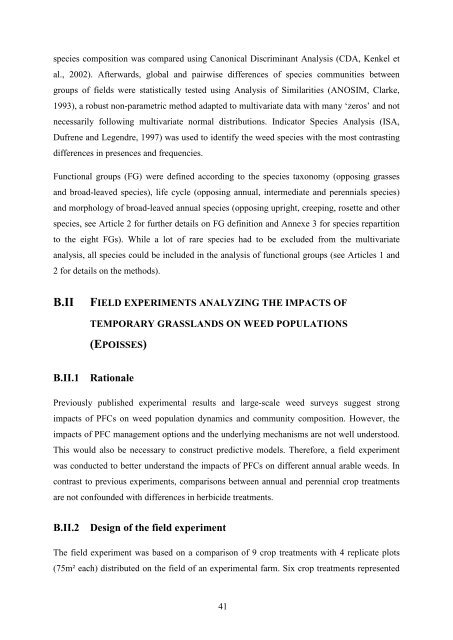Diversifying crop rotations with temporary grasslands - Université de ...
Diversifying crop rotations with temporary grasslands - Université de ...
Diversifying crop rotations with temporary grasslands - Université de ...
You also want an ePaper? Increase the reach of your titles
YUMPU automatically turns print PDFs into web optimized ePapers that Google loves.
species composition was compared using Canonical Discriminant Analysis (CDA, Kenkel et<br />
al., 2002). Afterwards, global and pairwise differences of species communities between<br />
groups of fields were statistically tested using Analysis of Similarities (ANOSIM, Clarke,<br />
1993), a robust non-parametric method adapted to multivariate data <strong>with</strong> many ‘zeros’ and not<br />
necessarily following multivariate normal distributions. Indicator Species Analysis (ISA,<br />
Dufrene and Legendre, 1997) was used to i<strong>de</strong>ntify the weed species <strong>with</strong> the most contrasting<br />
differences in presences and frequencies.<br />
Functional groups (FG) were <strong>de</strong>fined according to the species taxonomy (opposing grasses<br />
and broad-leaved species), life cycle (opposing annual, intermediate and perennials species)<br />
and morphology of broad-leaved annual species (opposing upright, creeping, rosette and other<br />
species, see Article 2 for further <strong>de</strong>tails on FG <strong>de</strong>finition and Annexe 3 for species repartition<br />
to the eight FGs). While a lot of rare species had to be exclu<strong>de</strong>d from the multivariate<br />
analysis, all species could be inclu<strong>de</strong>d in the analysis of functional groups (see Articles 1 and<br />
2 for <strong>de</strong>tails on the methods).<br />
B.II FIELD EXPERIMENTS ANALYZING THE IMPACTS OF<br />
TEMPORARY GRASSLANDS ON WEED POPULATIONS<br />
(EPOISSES)<br />
B.II.1 Rationale<br />
Previously published experimental results and large-scale weed surveys suggest strong<br />
impacts of PFCs on weed population dynamics and community composition. However, the<br />
impacts of PFC management options and the un<strong>de</strong>rlying mechanisms are not well un<strong>de</strong>rstood.<br />
This would also be necessary to construct predictive mo<strong>de</strong>ls. Therefore, a field experiment<br />
was conducted to better un<strong>de</strong>rstand the impacts of PFCs on different annual arable weeds. In<br />
contrast to previous experiments, comparisons between annual and perennial <strong>crop</strong> treatments<br />
are not confoun<strong>de</strong>d <strong>with</strong> differences in herbici<strong>de</strong> treatments.<br />
B.II.2 Design of the field experiment<br />
The field experiment was based on a comparison of 9 <strong>crop</strong> treatments <strong>with</strong> 4 replicate plots<br />
(75m² each) distributed on the field of an experimental farm. Six <strong>crop</strong> treatments represented<br />
41

















